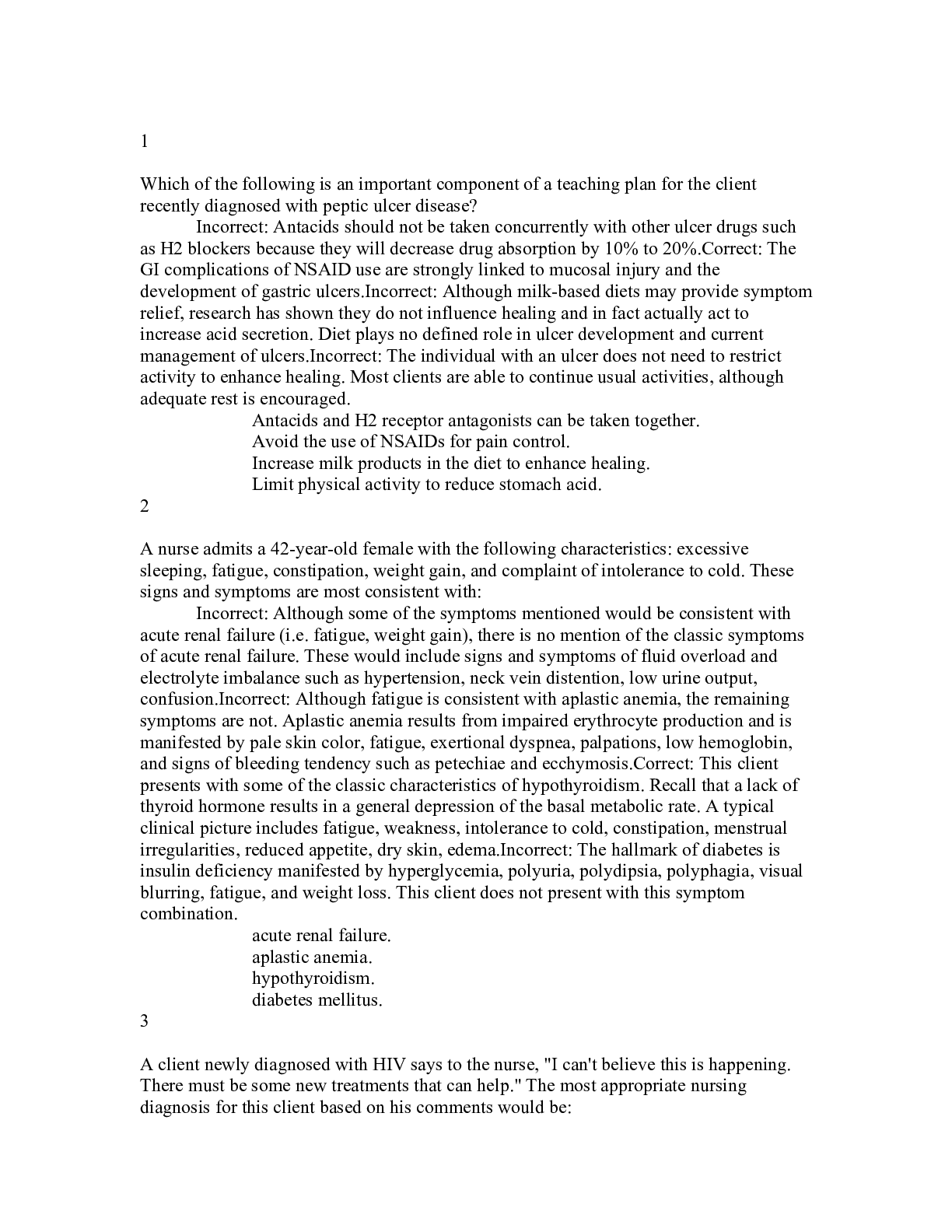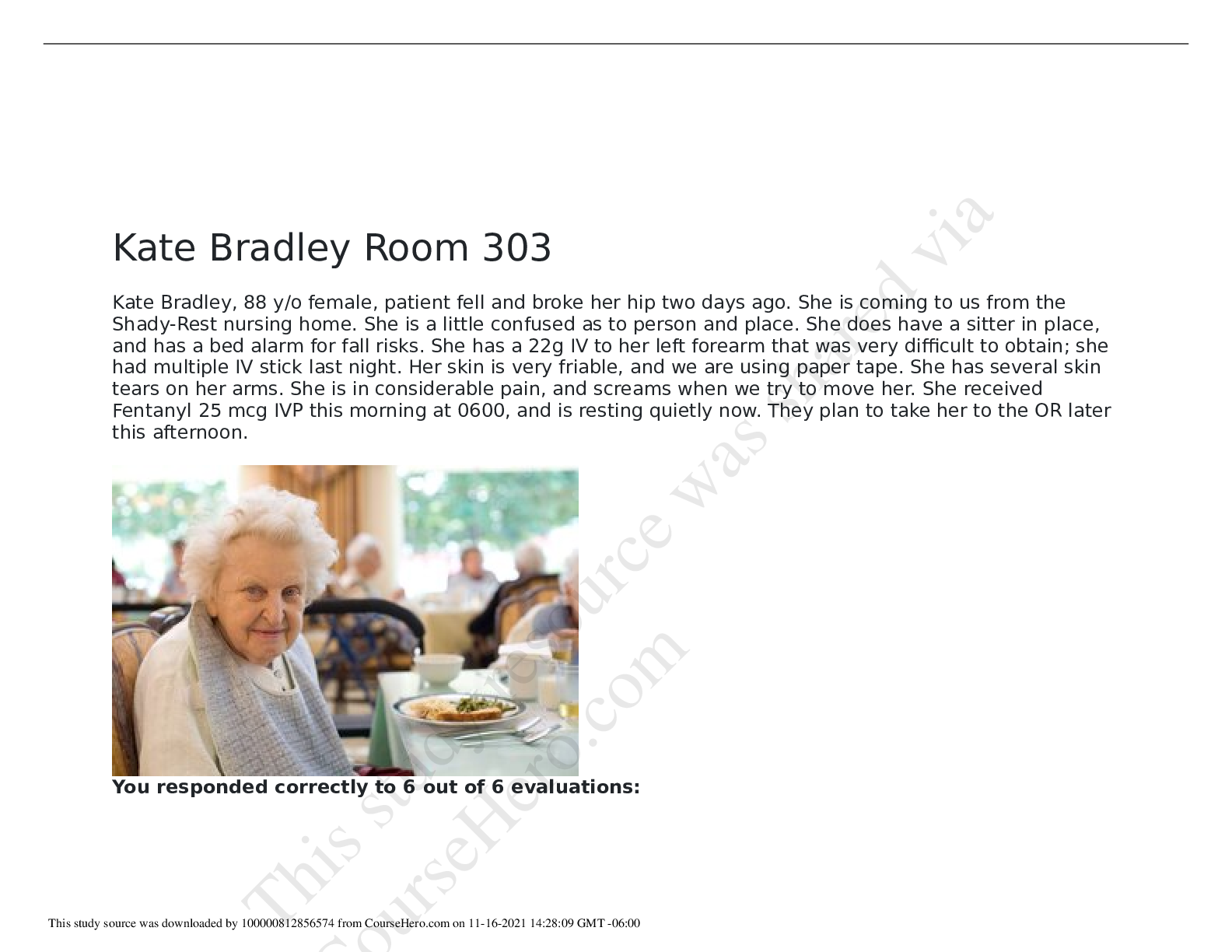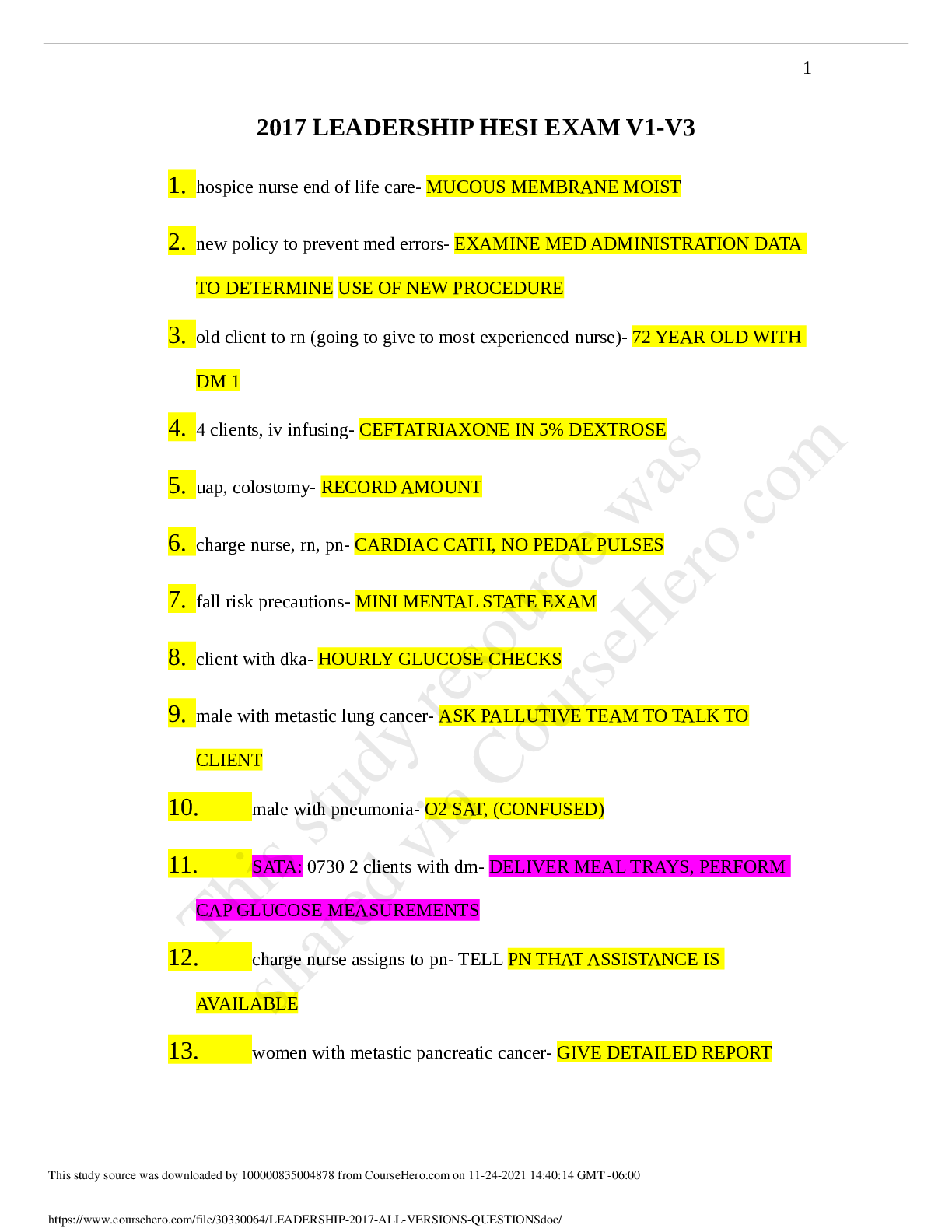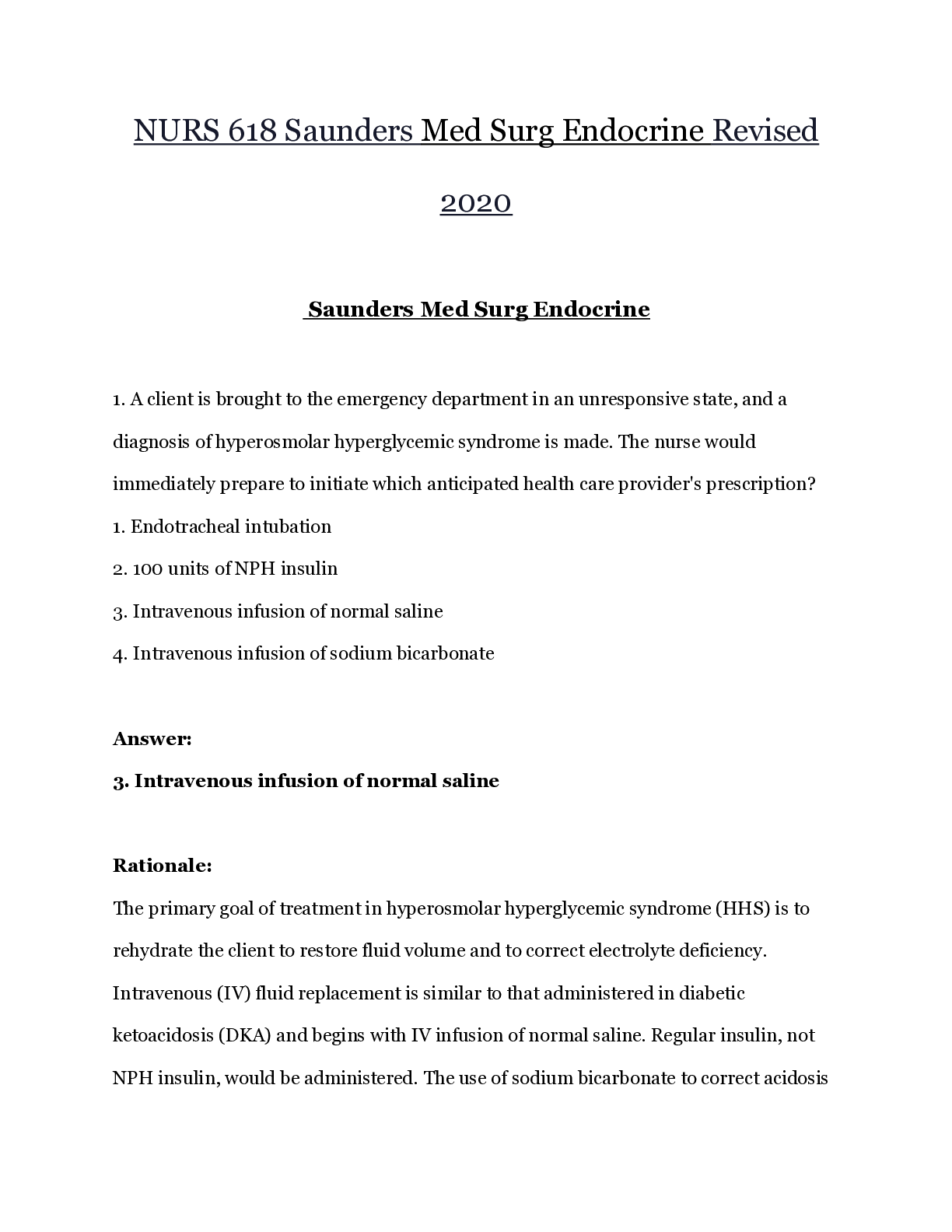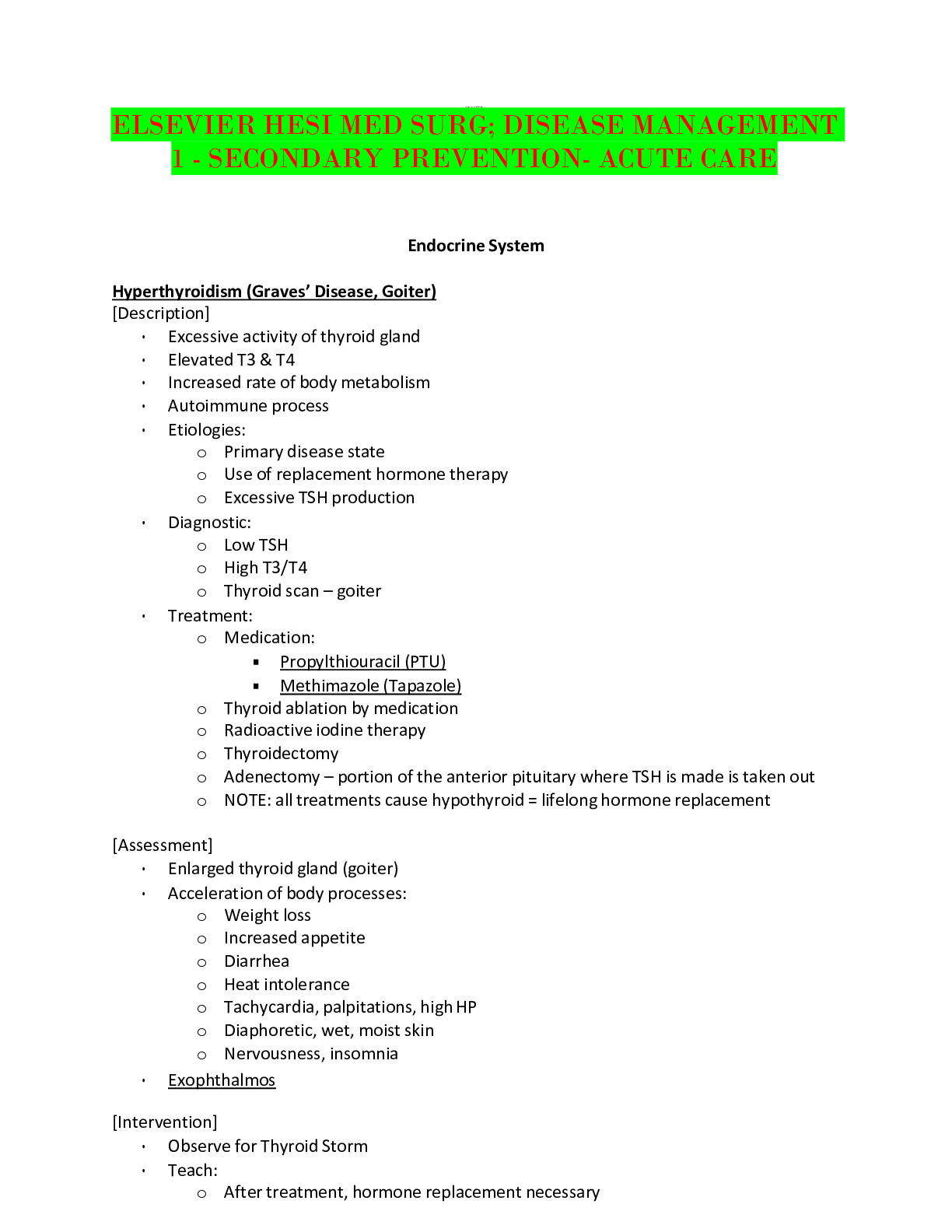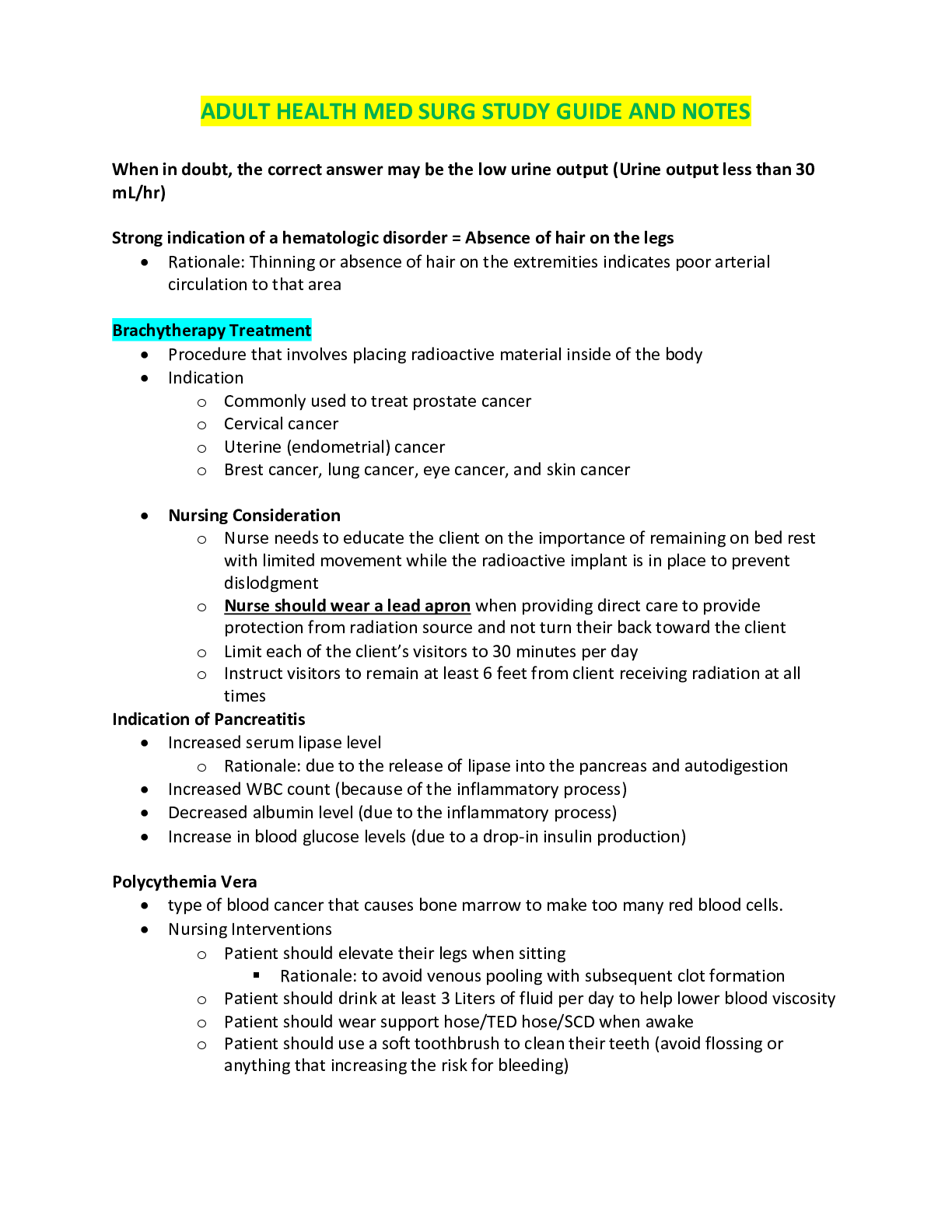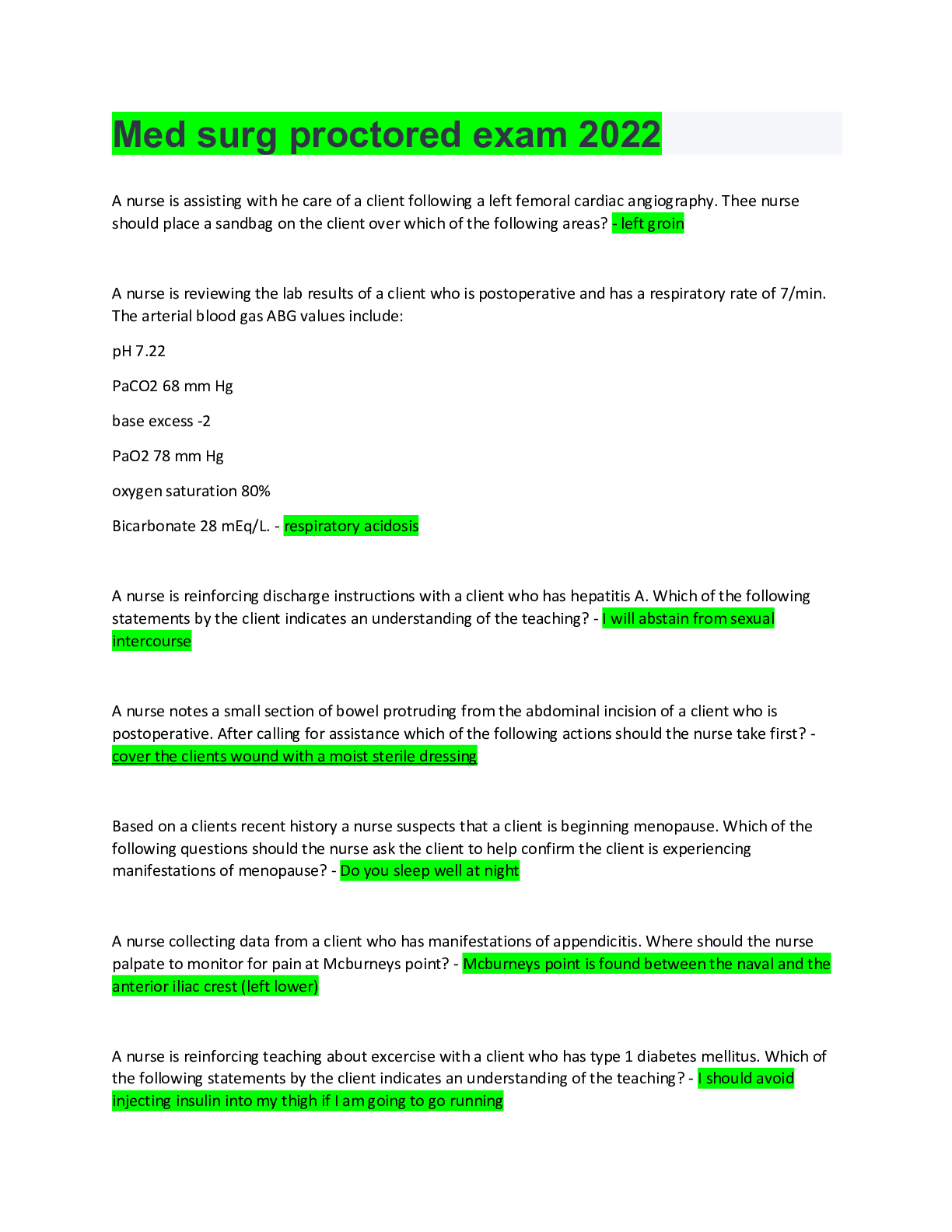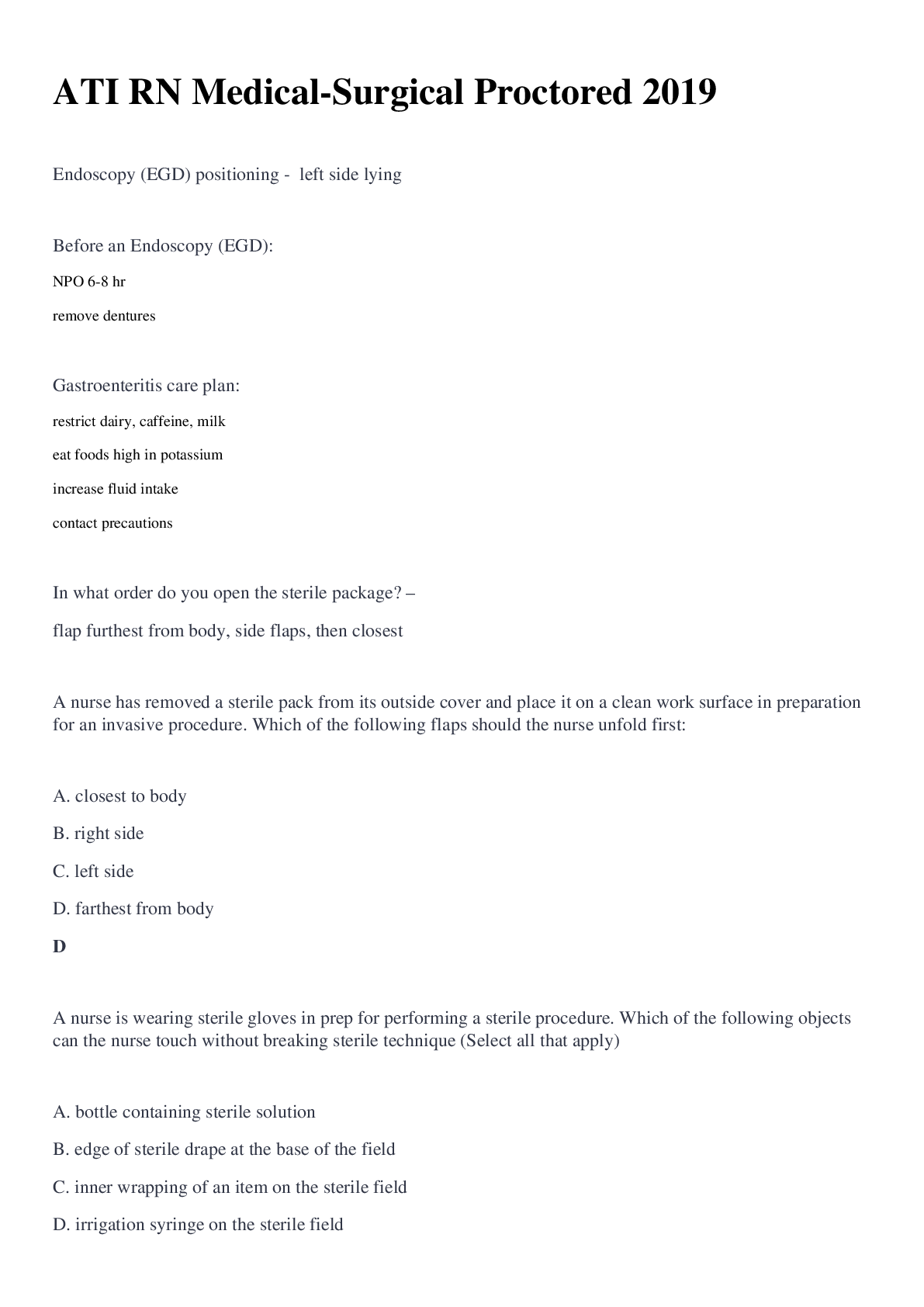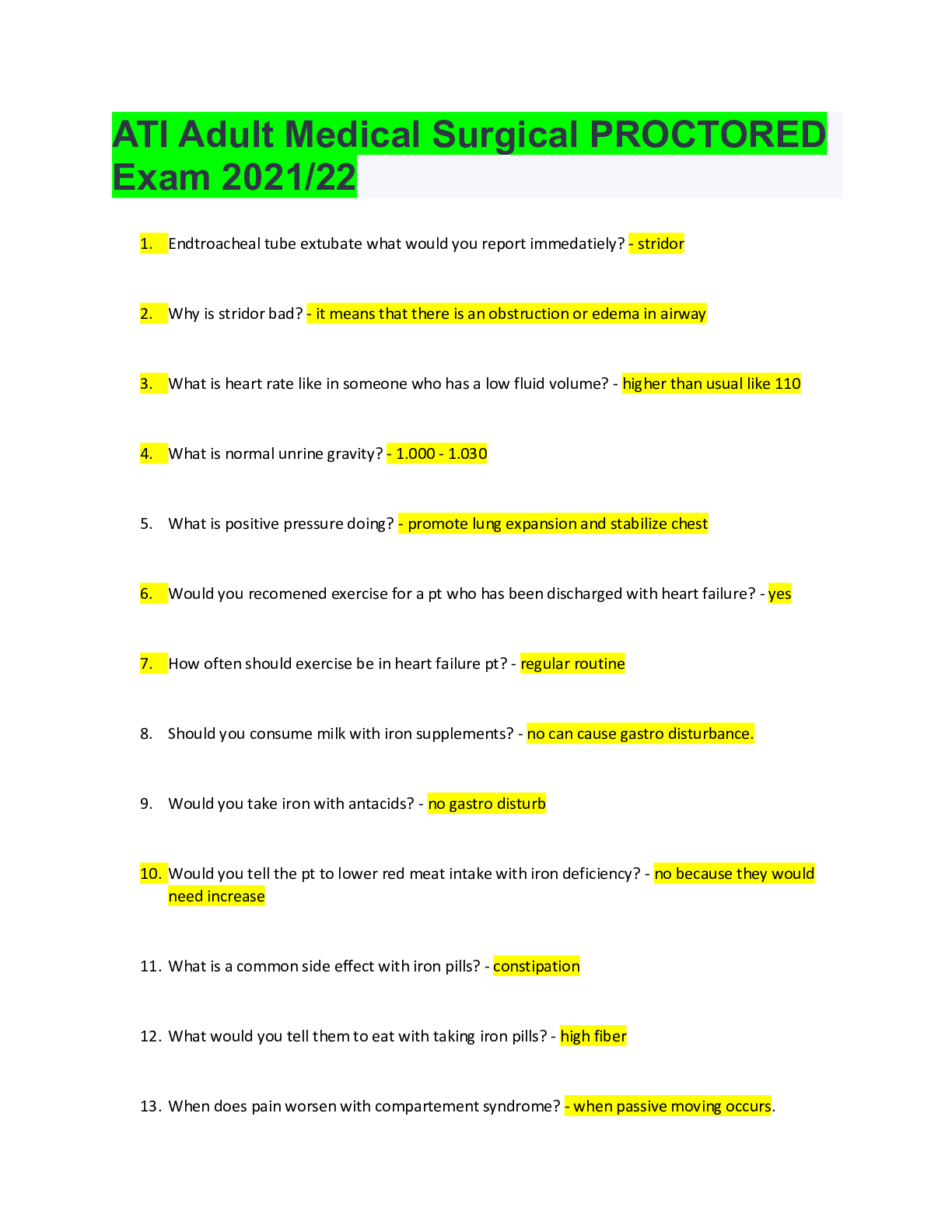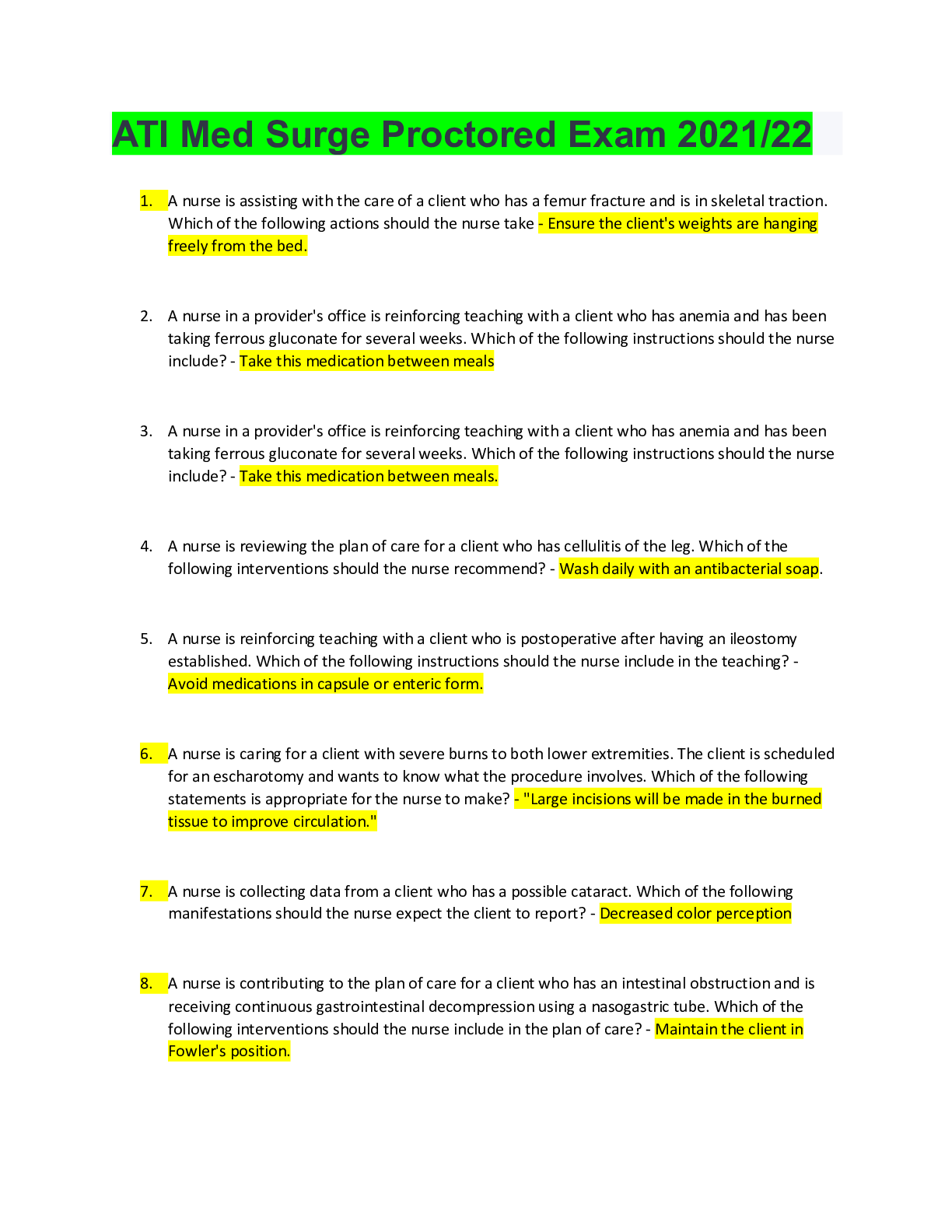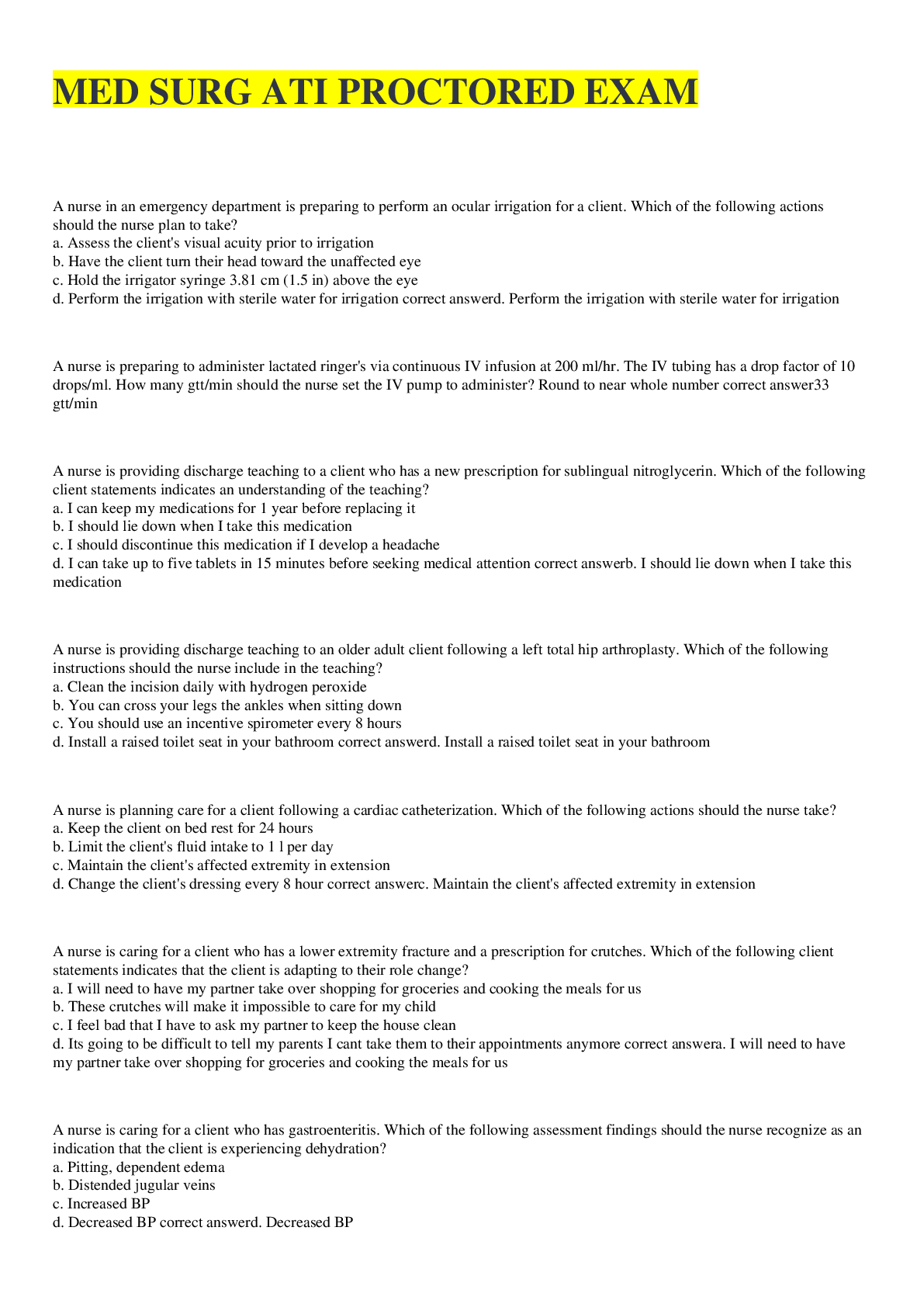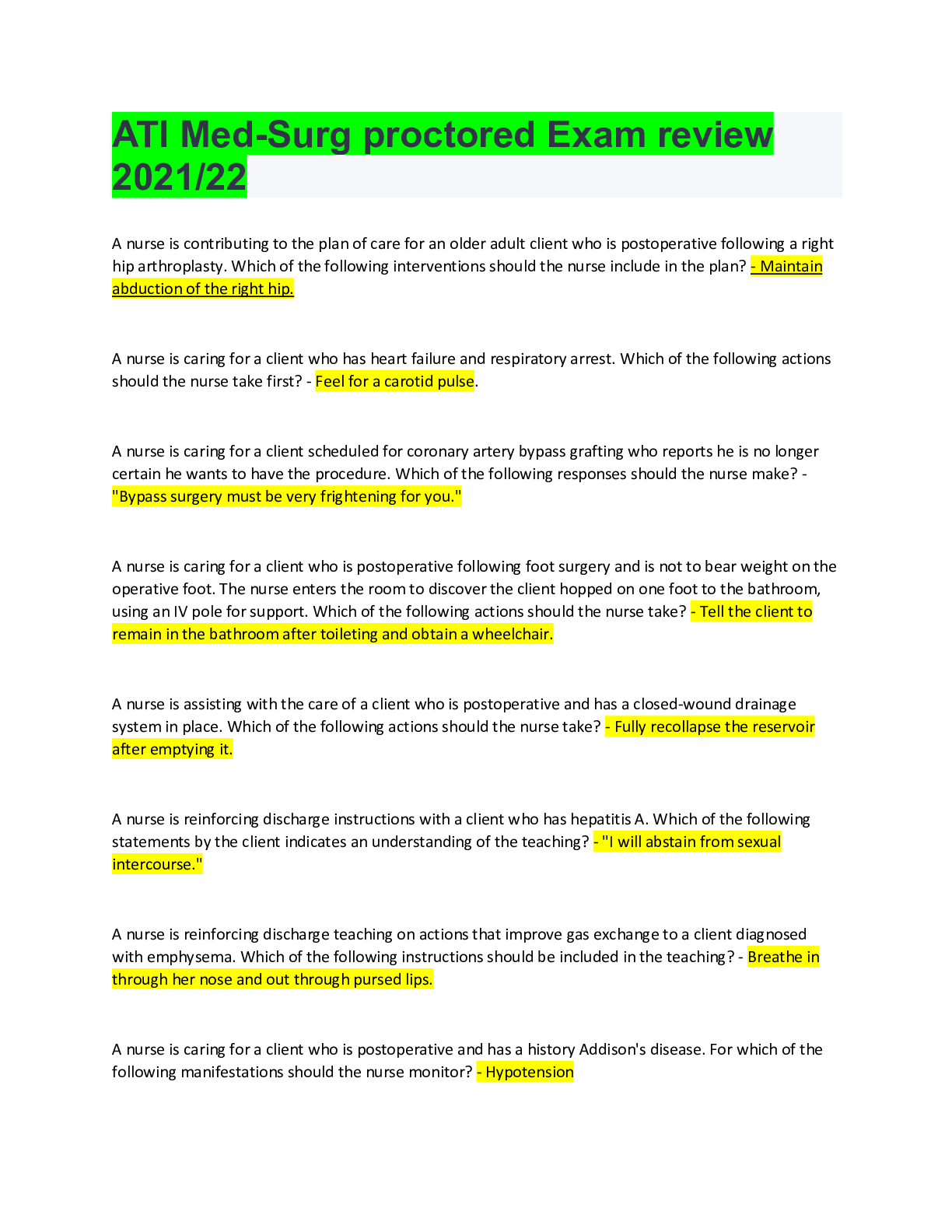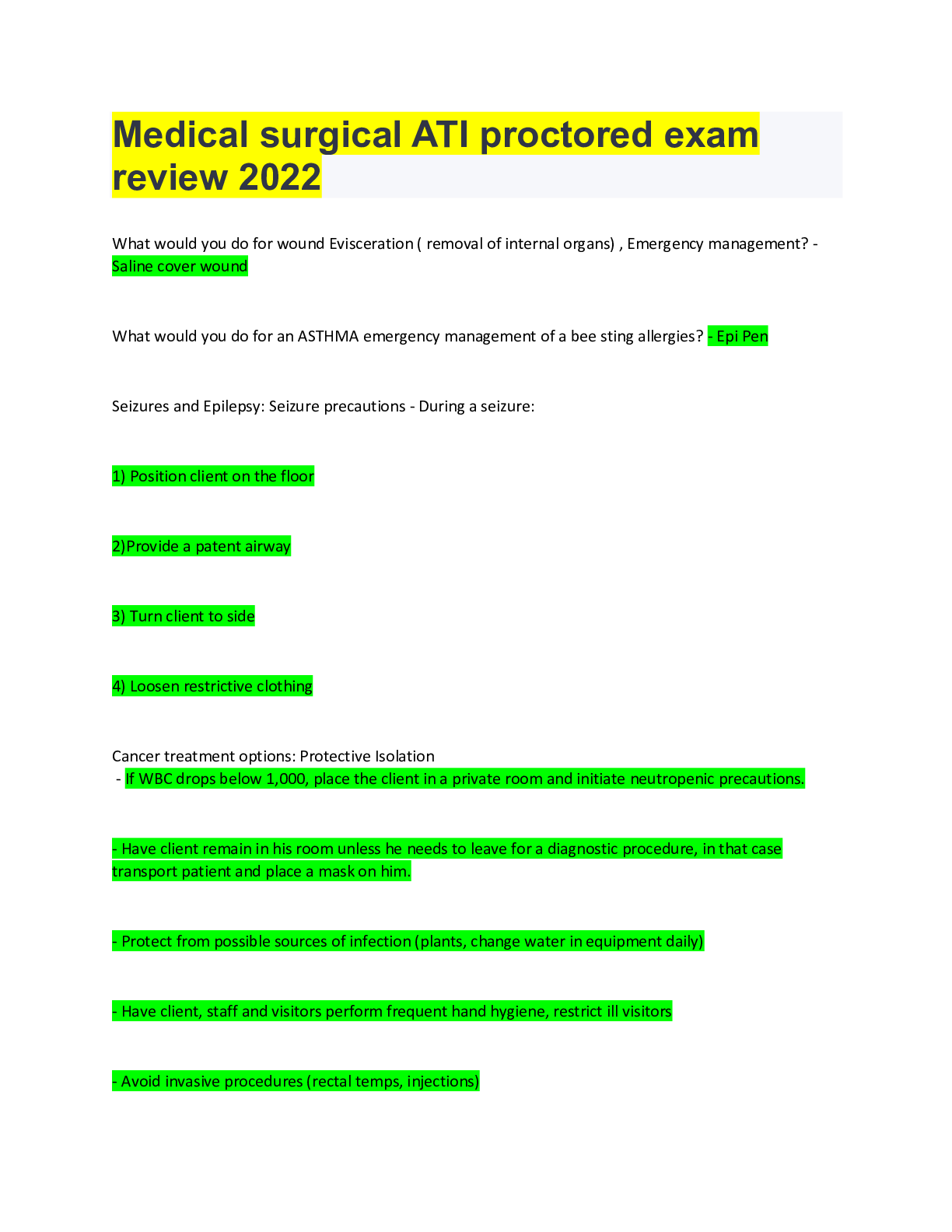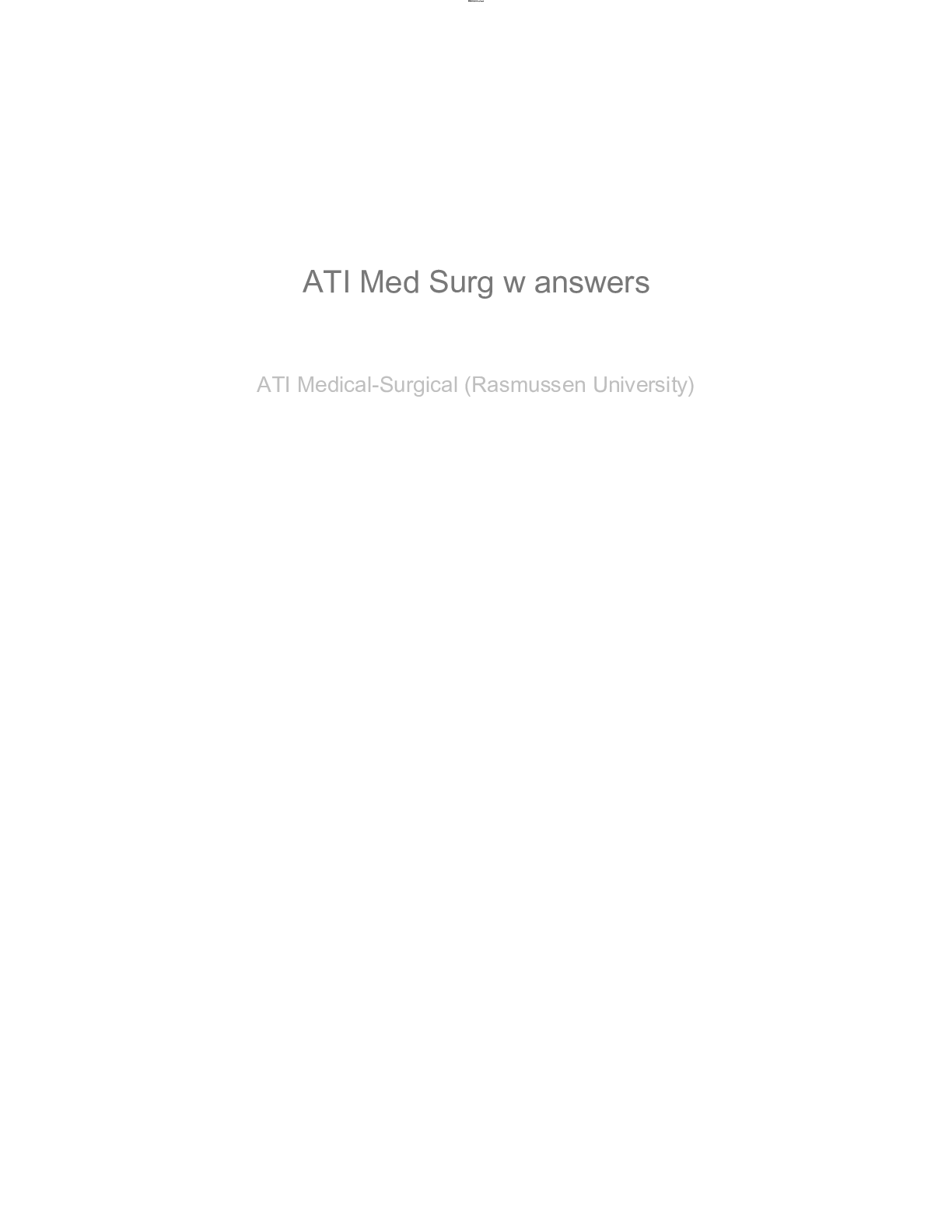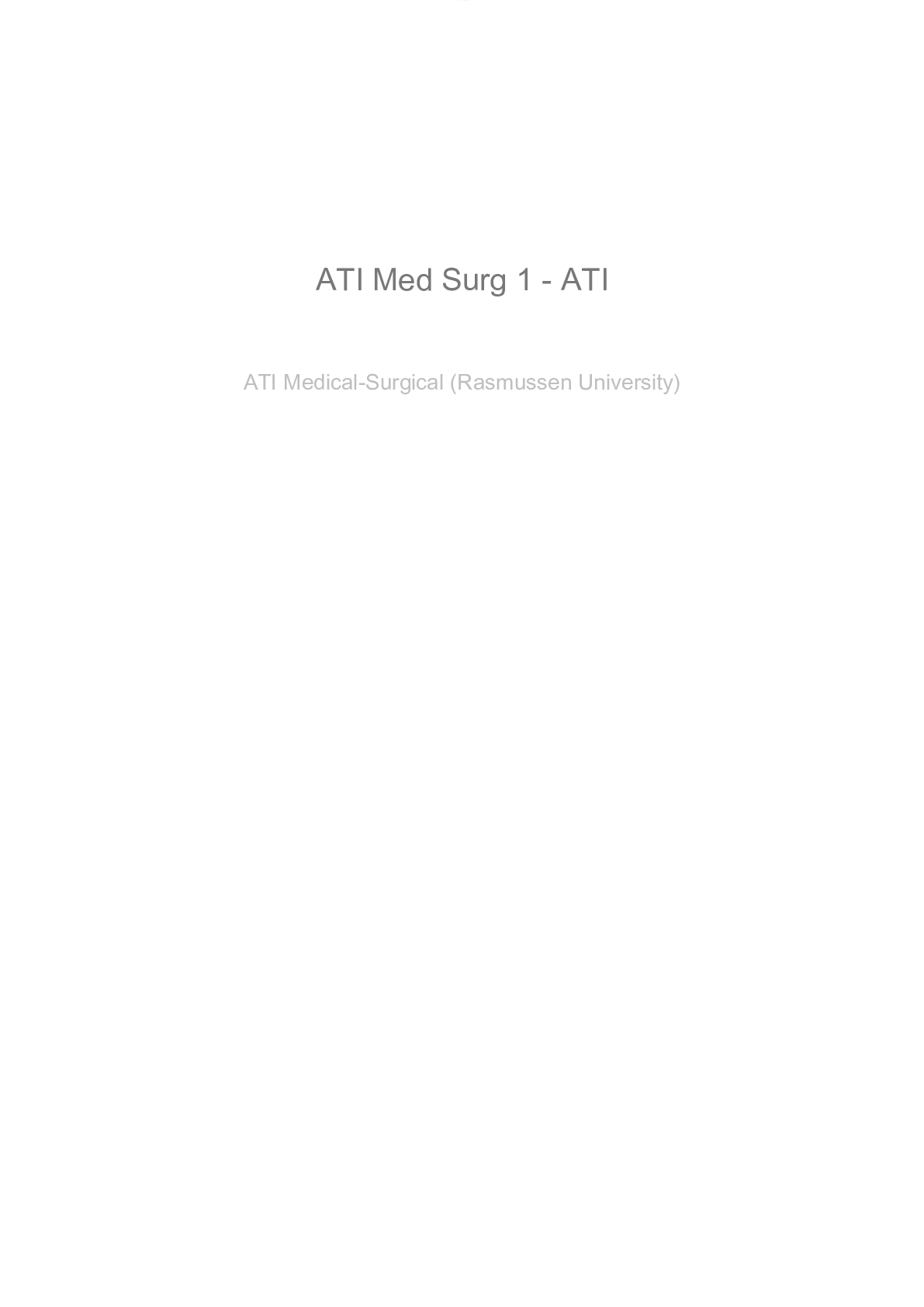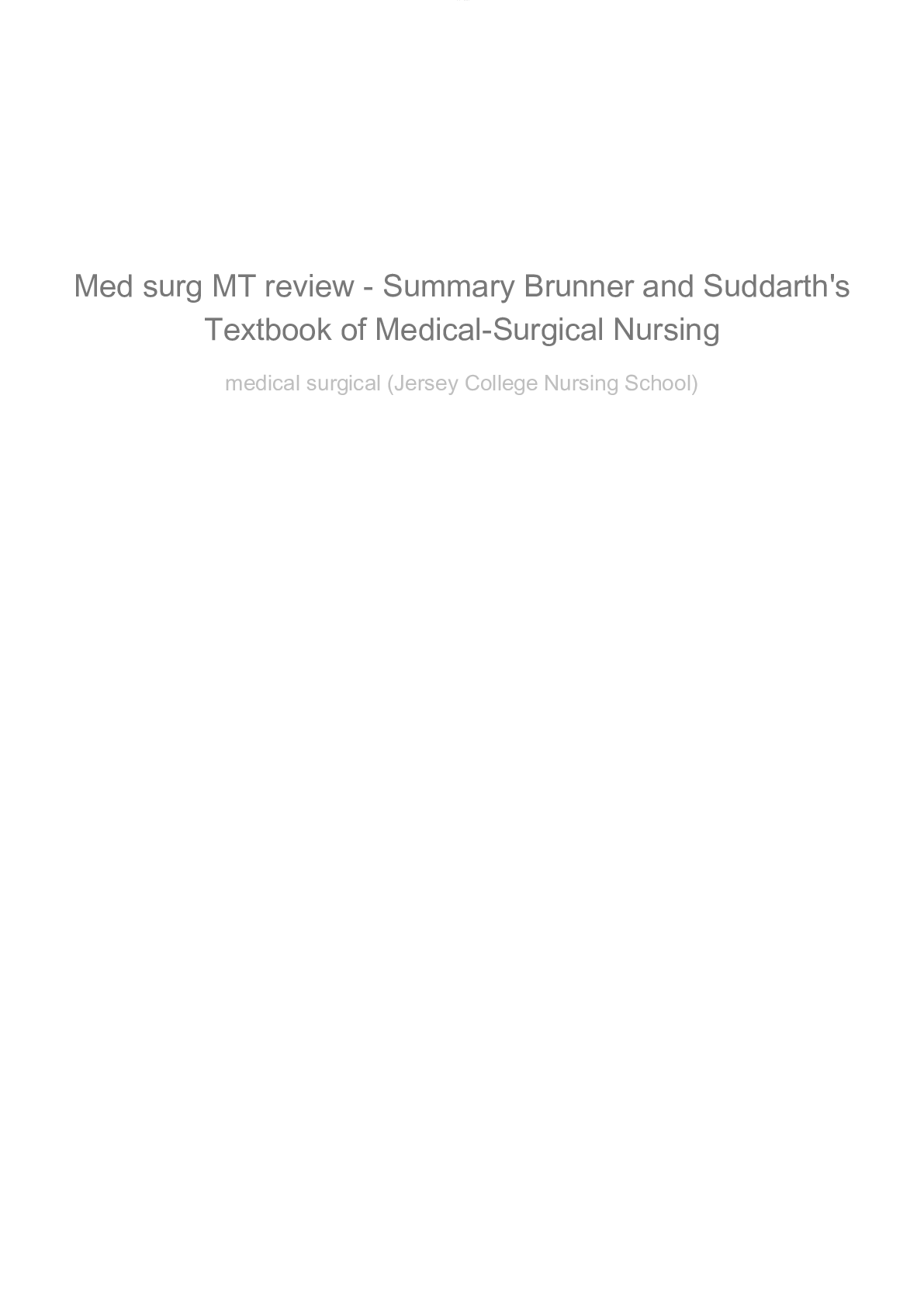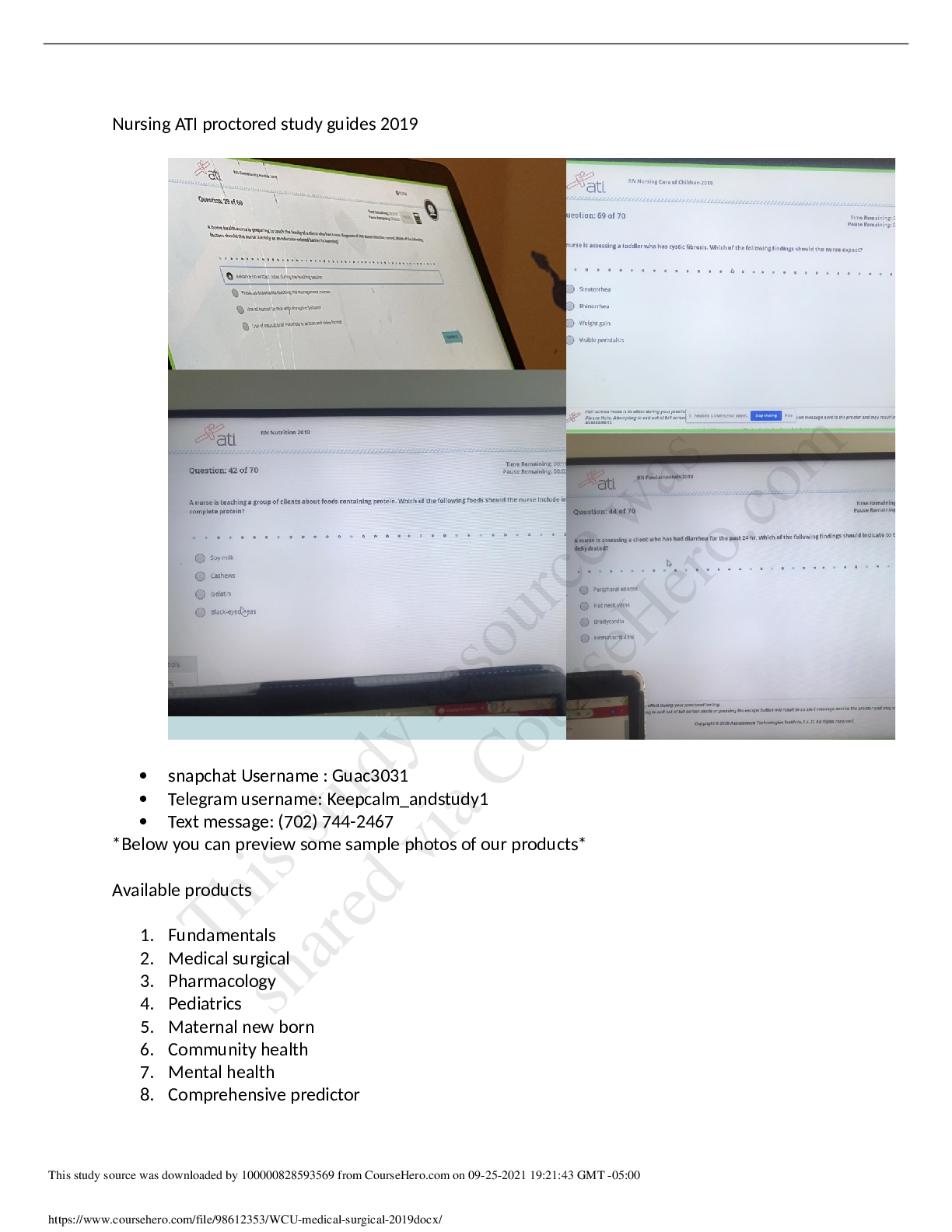*NURSING > MED-SURG EXAM > U-world Mental Health Nursing Complete Test Bank, questions/answers/elaborations (All)
U-world Mental Health Nursing Complete Test Bank, questions/answers/elaborations
Document Content and Description Below
Mental Health Nursing Neurologic Coup-Contrecoup Injury 1 of 13 A A A A speeding driver sustained a closed-head injury in an acceleration/deceleration accident from strik... ing a tree front end first. Based on the coup-contrecoup phenomenon, which assessments are most likely to be affected related to the involved areas of the brain? Unordered Options Ordered Response 1. Expressive speech, vision 2. Light touch, hearing 3. Sense of position, graphesthesia 4. Weber tuning fork test, cranial nerve I You answered this question correctly. Time Spent: 41 Seconds 69% of people answered this question correctly. Explanation Coup-contrecoup injury occurs when a body in motion stops suddenly (eg, head hits car windshield), causing contusions (bruising) of brain tissue as the brain moves back and forth within the skull. First, the soft tissue strikes the hard skull in the same direction as the momentum (coup). As the body bounces back, the brain strikes the opposing side of the skull (contrecoup). When the forward collision occurred, the frontal lobe most likely suffered the primary impact (coup). Executive function, memory, speech (Broca area), and voluntary movement are controlled by the frontal lobe. The contrecoup most likely injured the occipital lobe, where vision is processed. (Option 2) The temporal lobe (lateral aspect of the brain) controls hearing and integrates sensory data (eg, auditory, visual, somatic). The Wernicke speech area in the temporal lobe is responsible for language comprehension. Light touch is processed by the sensory cortex in the parietal lobe. (Option 3) An interruption of sensory function indicates injury to either the spinal column or the parietal lobe. These injuries affect proprioception (awareness of body positioning) and graphesthesia (ability to identify writing on the skin, by touch). (Option 4) The Weber test screens for conductive hearing loss by checking whether a tuning fork held along the midline of the head is heard evenly in both ears. Cranial nerve I is the olfactory nerve. Hearing and smell are both processed by the temporal lobe. Educational objective: Coup-contrecoup injuries usually affect the frontal and occipital lobes. The frontal lobe controls executive function, memory, speech, and motor skills. The occipital lobe processes vision. Mental Health Concepts Characteristics Of ADHD Test Id: 52191858 Question Id: 31967 (729561) 2 of 13 A A A The student nurse is performing an assessment of a 10-year-old diagnosed with attention-deficit hyperactivity disorder (ADHD). In addition to the 3 core symptoms of ADHD (hyperactivity, impulsiveness, and inattention), which of the following would the student nurse expect to find during the assessment? Unordered Options Ordered Response 1. Confusion and a learning disability 2. Delayed physical and emotional development 3. Disorientation and cognitive impairment 4. Low self-esteem and impaired social skills You answered this question correctly. Time Spent: 19 Seconds 49% of people answered this question correctly. Last Updated: 12/20/2015 Explanation The core symptoms of ADHD include hyperactivity, impulsiveness, and inattention. Hyperactive children are restless; have difficulty remaining seated when required; and exhibit excessive talking, blurting out answers prematurely, and interrupting others. Inattention is characterized by reduced ability to focus and attention to detail, easy distractibility, and failure to follow through (eg, homework, chores). The primary symptoms of ADHD have a negative impact and can make life difficult for children in school, at work, and in social situations. Symptoms interfere with opportunities to acquire social skills and may also result in rejection and critical judgment by peers. The negative consequences of ADHD include: • Poor self-esteem • Increased risk for depression and anxiety • Increased risk for substance abuse • Academic or work failure • Trouble interacting with peers and adults (Option 1) Children with ADHD are more likely to have a learning disability. Confusion is not a typical clinical finding. (Option 2) Although children with ADHD may appear to be emotionally immature for their age, ADHD is not associated with delayed physical growth. (Option 3) Children with ADHD are not disoriented. ADHD is associated with a range of cognitive impairments, but no single cognitive dysfunction typifies all children with the disorder. Some children have no impairment at all. Educational objective: The diagnosis of ADHD includes the presence of hyperactivity, impulsiveness, and inattention. The negative consequences of the core manifestations include impaired social skills, poor self-esteem, academic or work failure, increased risk for depression and anxiety, and increased risk for substance abuse. Mental Health Concepts ADHD Combined Type - Characteristics Test Id: 52191858 Question Id: 31965 (729561) 3 of 13 A A A The registered nurse is counseling the parent of a child recently diagnosed with attention-deficit hyperactivity disorder (ADHD), combined type. Which statement by the parent requires an intervention? Unordered Options Ordered Response 1. "I should offer a choice between 2 things for my child's clothes or meals." 2. "I will need to advocate for an individualized educational plan for my child." 3. "My child will outgrow this disorder around age 20." 4. "When talking with my child, I should not be multi-tasking." You answered this question correctly. Time Spent: 29 Seconds 75% of people answered this question correctly. Last Updated: 12/20/2015 Explanation Symptoms of ADHD usually continue into adulthood; current research indicates that children do not outgrow the condition. However, individuals with ADHD learn to cope with and manage the symptoms and achieve their full potential, leading healthy and satisfying lives. They may move into a condition of being "recovered," but this is usually a dynamic and ongoing state. (Option 1) Children with ADHD are usually overwhelmed and overstimulated when faced with numerous choices. Offering 2 choices will help organize and structure the child's decision-making process. (Option 2) There are legal mandates requiring school-based services and accommodations for children with ADHD. However, some teachers and/or school systems may not be as familiar with these requirements; it is important that parents of children with ADHD advocate for these individualized services. (Option 4) Parents and caregivers should make direct eye contact and focus on their children when giving instructions. Other distractions should be minimized to avoid overstimulation. Educational objective: Two common misunderstandings about ADHD are that children outgrow it as they become adults, and that dietary modifications (eg, restricting additives and/or sugar) will improve or "cure" the symptoms. Neither statement is true. These individuals learn to cope with and manage their symptoms as they grow older, but they do not outgrow ADHD. Mental Health Concepts Defense Mechanisms - Displacement Test Id: 52191858 Question Id: 31980 (729561) 4 of 13 A A A The nurse on the mental health unit recognizes the use of which defense mechanism when a client leaves a stressful family meeting and immediately begins to verbally abuse a roommate? Unordered Options Ordered Response 1. Compensation 2. Displacement 3. Projection 4. Reaction formation You answered this question correctly. Time Spent: 17 Seconds 57% of people answered this question correctly. Last Updated: 12/20/2015 Explanation Displacement, one of many ego defense mechanisms, occurs when a person shifts uncomfortable feelings or impulses about one situation or person to a substitute situation or person deemed acceptable to receive these uncomfortable feelings or impulses. (Option 1) Compensation involves experiencing a perceived deficit in one area and making up for it by overachieving in another. An example is someone not doing well academically who focuses on doing well in sports. (Option 3) Projection involves feeling uncomfortable with an impulse or feeling and easing the anxiety by assigning it to another person. An example is a husband with thoughts of infidelity who then accuses his wife of being unfaithful. (Option 4) Reaction formation involves transforming an unacceptable feeling or impulse into its opposite. An example is a client with cancer who fears dying but behaves in an overly optimistic and fearless manner about his treatment and prognosis. Educational objective: Displacement is an ego defense mechanism that involves transferring uncomfortable feelings, emotions, or impulses about one person or situation to a substitute person or situation. Copyright © UWorld. Mental Health Concepts Acute Mania - Care Plan Test Id: 52191858 Question Id: 30748 (729561) 5 of 13 A A A Which of the following actions would the nurse include in planning care for a client hospitalized for bipolar disorder, acute manic episode? Select all that apply. Unordered Options Ordered Response 1. Assign the client to a private room 2. Choose clothing for the client 3. Have the client be in charge of planning an outing for the unit 4. Have the client join other clients in the dining room for meals 5. Have the client participate in physical exercise with a staff member 6. Include the client in group therapy sessions You answered this question incorrectly. Correct answer is: 1,2,5 Time Spent: 77 Seconds 25% of people answered this question correctly. Last Updated: 11/9/2015 Explanation In developing a care plan for a client experiencing acute mania, the nurse is aware that an acute manic episode is characterized by the following: • Excessive psychomotor activity • Euphoric mood • Poor impulse control • Flight of ideas, non-stop talking • Poor attention span, distractibility • Hallucinations and delusions • Insomnia • Wearing bizarre or inappropriate clothing, jewelry, and makeup • Neglected hygiene and inadequate nutritional intake The care plan for a client experiencing an acute manic episode includes the following: • Reduction of environmental stimuli o Providing a quiet, calm environment o Limiting the number of people who come in contact with the client o One-on-one interactions rather than group activities o Low lighting • A structured schedule of activities to help the client stay focused • Physical activities to help relieve excess energy • Providing high-protein, high-calorie meals and snacks that are easy to eat • Setting limits on behavior (Option 3) The client is easily distractible and would not be able to focus on planning an activity. (Option 4) The client who is experiencing an acute manic episode needs reduced environmental stimuli. Eating with other clients in the dining room would be too stimulating and could exacerbate psychomotor activity. (Option 6) The client with acute mania is not ready to participate in group activities. Educational objective: The nursing care plan for clients with acute mania includes providing a quiet, structured, non-stimulating environment; engaging the client in one-on-one activities and physical activity; limiting contact with other people; and providing foods of high nutritional value that are easy to eat. Mental Health Concepts Histrionic Personality Disorder - Characteristics Test Id: 52191858 Question Id: 33456 (729561) 6 of 13 A A A The nurse assigned to care for the client with a diagnosis of histrionic personality disorder expects to observe which characteristics and behaviors? Unordered Options Ordered Response 1. Fears abandonment, agreeable, needs constant reassurance 2. Likes to be the center of attention, exaggerated emotional expression, little tolerance for frustration 3. Seems uncomfortable around people, lack of close friends, indifferent to praise or criticism 4. Tries to intimidate others, manipulative, lacks empathy You answered this question correctly. Time Spent: 69 Seconds 58% of people answered this question correctly. Last Updated: 11/9/2015 Explanation The nurse should recognize the following characteristics associated with histrionic personality disorder: • Self-dramatizing, exaggerated or shallow emotional expression • Attention-seeking, needs to be the center of attention • Overly friendly and seductive, attempts to keep others engaged • Demands immediate gratification and has little tolerance for frustration An individual with histrionic personality disorder displays these behaviors and characteristics persistently. The signs and symptoms are maladaptive and have a negative impact on the client's social, interpersonal, and occupational life. (Option 1) Clients with dependent personality disorder fear separation and tend to be indecisive and unable to take the initiative. They are often preoccupied with the thought of being left to fend for themselves and want others to assume responsibility for all major decision making. (Option 3) Clients with schizoid personality disorder exhibit social detachment and an inability to express emotion. They do not enjoy close relationships and prefer to be aloof and isolated. (Option 4) Clients with antisocial personality disorder have a pattern of disregard for and violation of the rights of others. They manipulate others for personal gain and lack empathy. Educational objective: Histrionic personality disorder is characterized by persistent attention-seeking behavior and exaggerated emotionality. The client with this disorder demands immediate gratification and has little tolerance for frustration. Mental Health Concepts Suicidal Behavior/Suicide Test Id: 52191858 Question Id: 30686 (729561) 7 of 13 A A A The home health aide reports to the nurse care manager that the client has been trying to give away possessions. When the nurse asks the client about this behavior, the client says, "With my spouse dead, there's no reason for me to go on." What is the best priority response by the nurse? Unordered Options Ordered Response 1. "Do you have any friends in the building?" 2. "Have you had any thoughts of hurting yourself?" 3. "Tell me more about how you're feeling." 4. "You're not thinking of killing yourself, are you?" You answered this question correctly. Time Spent: 1955 Seconds 70% of people answered this question correctly. Last Updated: 11/26/2015 Explanation Giving away possessions and making statements such as, "There is no reason for me to go on," are indications of suicidal ideation. The most important nursing action is to perform a suicide risk assessment to determine interventions to ensure the client's safety. Determining if the client has had thoughts of self harm is a priority. The nurse can ask the client direct questions such as, "Do you feel like hurting yourself?" or "Are you thinking about killing yourself?" or "Do you want to die?" During the assessment, it is important for the nurse to create a sense of trust and compassion and engage the client in a nonjudgmental manner. Additional questions that are part of a suicide risk assessment include the following: • Have you thought about how you would kill yourself? • Do you have a plan to kill yourself? • If you were to kill yourself, how would you do it? If the client has a suicide plan, the nurse needs to ask about the details. The risk of a client completing suicide increases when the client has planned for a specific time and place, has chosen a highly lethal method (eg, firearm, hanging), and has chosen circumstances in which there would be little or no chance of interruption. (Option 1) It is important to assess the client's social support system, but it is not the priority assessment. (Option 3) This is not the priority assessment; it is more important to determine if the client is thinking about suicide or has a plan. (Option 4) This is a leading question and implies what the answer should be. Educational objective: A suicide risk assessment is the priority nursing action for a client who expresses thoughts about "not wanting to go on" or "wishing for death" or engages in potential suicidal indicators such as giving away possessions. Asking the client directly about thoughts of hurting or killing oneself is a therapeutic approach and an essential component of the risk assessment. Mental Health Concepts Schizophrenia - Hallucinations - Interventions Test Id: 52191858 Question Id: 30536 (729561) 8 of 13 A A A A client recently diagnosed with schizophrenia is hospitalized. The client appears distraught and says to the nurse, "The voices are bad today…they are so angry with me." Which of the following is the best response by the nurse? Unordered Options Ordered Response 1. "Do you need something to help you calm down?" 2. "Don't pay any attention to the voices. Let's go into the dayroom." 3. "The voices are not real. Tell them to go away." 4. "What are the voices saying to you?" You answered this question incorrectly. Time Spent: 61 Seconds 84% of people answered this question correctly. Last Updated: 1/5/2016 Explanation The priority nursing action is to explore the content of the hallucinations. This client may be experiencing command auditory hallucinations that could lead to self-directed or other-directed injury and harm. After the content of the hallucinations has been explored, implementing an intervention may be necessary to reduce the potential for violence. Hallucinations are false sensory perceptions that have no external stimuli. They can occur in any of the 5 senses. Auditory hallucinations are the most common, followed by visual, tactile (touch), olfactory (smell), and gustatory (taste). Additional ways to deal with hallucinations include the following: • Telling the client that you know they are real to the client but that you do not hear the voices (or see the vision, feel the sensation) • Not arguing with or challenging the client about the hallucinations • Directing the client to a reality-oriented topic of conversation or activity (Option 1) An antianxiety medication may be needed if the voices are causing this client to become increasingly distressed. Assessment is needed before choosing this option. (Option 2) This choice dismisses this client's concerns about the nature of the voices. (Option 3) Telling the voices to "go away" (voice dismissal) is a technique that some clients find effective in management of hallucinations. It is not the priority nursing action in this client. Educational objective: It is important for the nurse to initially explore the content of a client's hallucinations to assess the risk for harm and/or injury and determine appropriate interventions. The nurse can tell the client that the nurse knows the voices are real to the client but are not heard by the nurse. The client with hallucinations should be directed to reality-oriented activities rather than to further discussion of the content of the hallucinations. ******************************************************CONTINUED................************************** [Show More]
Last updated: 1 year ago
Preview 1 out of 159 pages
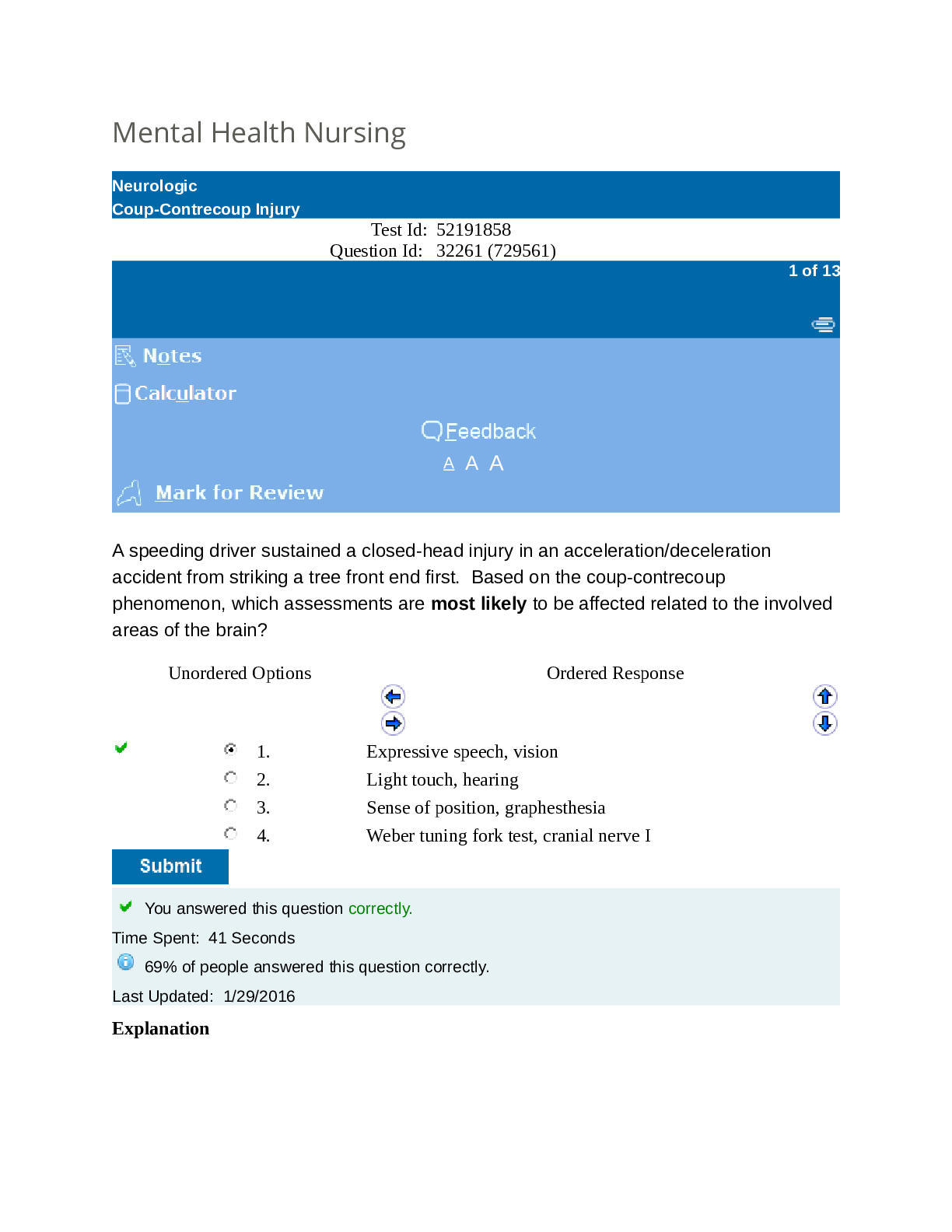
Reviews( 0 )
Document information
Connected school, study & course
About the document
Uploaded On
Nov 19, 2020
Number of pages
159
Written in
Additional information
This document has been written for:
Uploaded
Nov 19, 2020
Downloads
0
Views
109

